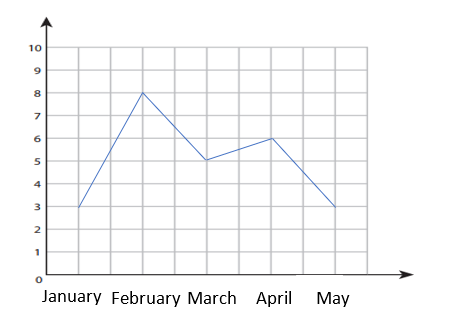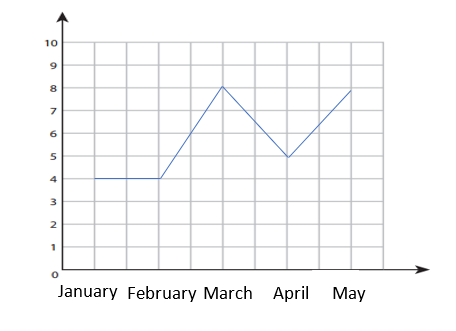Line Graphs
In this article, we are going to give you complete information about line graphs and how to use them.

What’s a Line Graph?
Line graphs, additionally known as line charts, are utilized to correspond to quantitative information accumulated over a particular subject as well as a particular timeframe.
All data points are linked via a line. The data points correspond to the reflections accumulated on a survey or some research.
A line graph has a \(y\)-axis and an \(x\)-axis. The \(x\)-axis typically has a timeframe by which we’d wish to measure the amount of a particular thing or an element in the \(y\)-axis.
Line graphs assist in analyzing the trend of if the amount in the \(y\)-axis is growing or reducing over a certain timeframe. Line graphs give a clear-cut picture of an improving or a declining trend.
The line’s slope is the top vital observation in this situation. A slope symbolizes how steep the line is. It assists in doing a comparison of the extent of the change between any \(2\) consecutive points on a graph. For instance: The sharper a slope is, the better is the changes in the scale between \(2\) consecutive points.
Related Topics
Line Graph parts
Line graphs consist of a vertical \(y\)-axis and a horizontal \(x\)-axis. The majority of line graphs simply deal with positive numeral values, hence these axes usually intersect close to the \(y\)-axis bottom and the left end of an \(x\)-axis. The point where these axes intersect is constantly \((0,0)\).
Each of the axes is labeled via a data type. For instance, an \(x\)-axis can be weeks, days, years, or quarters, whilst a \(y\)-axis displays revenue in dollars. The data points get plotted and attached via a line in a “dot-to-dot” approach.
Let’s learn about all the line graph’s parts.
- Title: A line graph title informs you what the graph’s subject is, i.e., the data is shown by the graph.
- Labels: A horizontal axis across the graph bottom and the vertical label along with its sideshow the types of info being portrayed.
- Scales: A horizontal scale across its bottom and a vertical scale along with its sideshow how many or how much.
- Points: Points or dots on a graph signify the \((x, y)\) coordinates or the ordered pairs. You can put more than one data line on a line graph. Here, information on its horizontal axis is an independent variable, and information on a \(y\)-axis is its dependent variable.
- Lines: Straight lines linking the points provide approximate values between the points.
Plotting Line Graphs
The subsequent steps are utilized to produce a line graph.
- Build a table: Draw \(x\)- and \(y\)-axes on the page. At the top put a title that briefly explains the chart’s purchase.
- Label each axis: If you are using time as a factor, it ought to go along its horizontal \((x)\) axis. The additional numeric values, such as the dependent variables calculated ought to be put along the vertical \((y)\) axis. Each axis ought to be labeled via the numeric system’s name along with the measurements you are using. For instance, you can label an \(x\)-axis with independent variables such as months or hours, showing each numeral written on the axis as the number of months or hours. Evenly divide each axis into appropriate increments.
- Add information: Information for line graphs is typically shown in a \(2\)-column table relating to the \(x\)- and \(y\)-axes. When the data has been entered, the line graph automatically reflects its values.
- Generate a key: If you/’re doing a comparison of several things, you will wish to make a key to identify what each of the lines is via the colors.
Line Graphs – Example:
The graph below shows the number of cars sold in a store over five months. Answer the following questions according to the graph.

- How many cars were sold in February?
- How many cars have been sold in five months?
- In which month were the most cars sold?
Solution:
The chart above is a line graph. To find out how many cars were sold in February, look at the point along the X-axis and February. This point shows the number \(8\). So the answer to question \(1\) is \(8\).
To find out the total number of cars sold in five months, find the points for each month on the chart and add these numbers together: \(3+8+5+6+3=25\). So the answer to question \(2\) is \(25\).
To answer the third question, we look at the lines on the graph: Which point is higher than the other points? The point for February, shows the number \(8\). So the answer to question \(3\) is February.
Exercises for Line Graphs
Tommy is a home appliance salesman. The following line graph shows the number of TVs Tommy has sold in five months. Answer the following questions according to this graph.

- How many TVs did Tommy sell in May?
- How many TVs has Tommy sold in these five months?
- In which month did Tommy sell the least TVs?

- \(8\)
- \(29\)
- January and February
Related to This Article
More math articles
- 10 Most Common 5th Grade FSA Math Questions
- The 5 Best Computers For College Students
- How to Find the Perimeter of Polygons? (+FREE Worksheet!)
- 5th Grade TCAP Math Worksheets: FREE & Printable
- SSAT Middle Level Math FREE Sample Practice Questions
- Divide and Conquer: How to Tackle Word Problems with Division Facts up to Twelve
- Complete Guide to Inverse Trigonometric Ratios
- Top 10 Free Websites for ACT Math Preparation
- A Comprehensive Collection of Free SHSAT Math Practice Tests
- Is your child ready for algebra 1?





























What people say about "Line Graphs - Effortless Math: We Help Students Learn to LOVE Mathematics"?
No one replied yet.